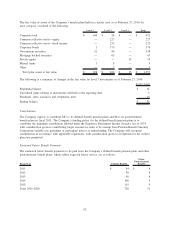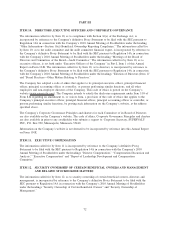Albertsons 2010 Annual Report Download - page 72
Download and view the complete annual report
Please find page 72 of the 2010 Albertsons annual report below. You can navigate through the pages in the report by either clicking on the pages listed below, or by using the keyword search tool below to find specific information within the annual report.were exercisable only under certain conditions, and may be redeemed by the Board of Directors for $0.01 per
right. The rights expired on April 12, 2010 and were not renewed.
NOTE 15—SEGMENT INFORMATION
Refer to the Consolidated Segment Financial Information for financial information concerning the Company’s
operations by reportable segment.
The Company’s operating segments reflect the manner in which the business is managed and how the
Company allocates resources and assesses performance internally. The Company’s chief operating decision
maker is the Chief Executive Officer.
The Company offers a wide variety of grocery products, general merchandise and health and beauty care,
pharmacy, fuel and other items and services. The Company’s business is classified by management into two
reportable segments: Retail food and Supply chain services. These reportable segments are two distinct
businesses, one retail and one wholesale, each with a different customer base, marketing strategy and
management structure. The Retail food reportable segment is an aggregation of the Company’s retail operating
segments, which are organized based on format (traditional retail food stores and hard-discount food stores).
The Retail food operating segments are aggregated as the products sold in the grocery stores are substantially
the same, focusing on food and related products; the customer or potential customer for each of the retail
operating segments is the same, any consumer of food and related products; each of the retail operating
segments use the same distribution method for its products, the sale of items through grocery stores; and all of
the Company’s retail operating segments are subject to similar regulation. Additionally, the retail operating
segments are aggregated into one Retail food reportable segment as they have similar economic characteristics
and are expected to have similar long-term financial performance, based on operating earnings as a percent of
sales.
The Retail food reportable segment derives revenues from the sale of groceries at retail locations operated by
the Company (both the Company’s own stores and stores licensed by the Company). The Supply chain
services reportable segment derives revenues from wholesale distribution to independently owned retail food
stores, mass merchants and other customers (collectively referred to as “independent retail customers”) and
logistics support services.
The Company offers a wide variety of nationally advertised brand name and private-label products, primarily
including grocery (both perishable and nonperishable), general merchandise and health and beauty care,
pharmacy and fuel, which are sold through the Company’s own and licensed retail food stores to shoppers and
through its Supply chain services business to independent retail customers. The amounts and percentages of
66
























